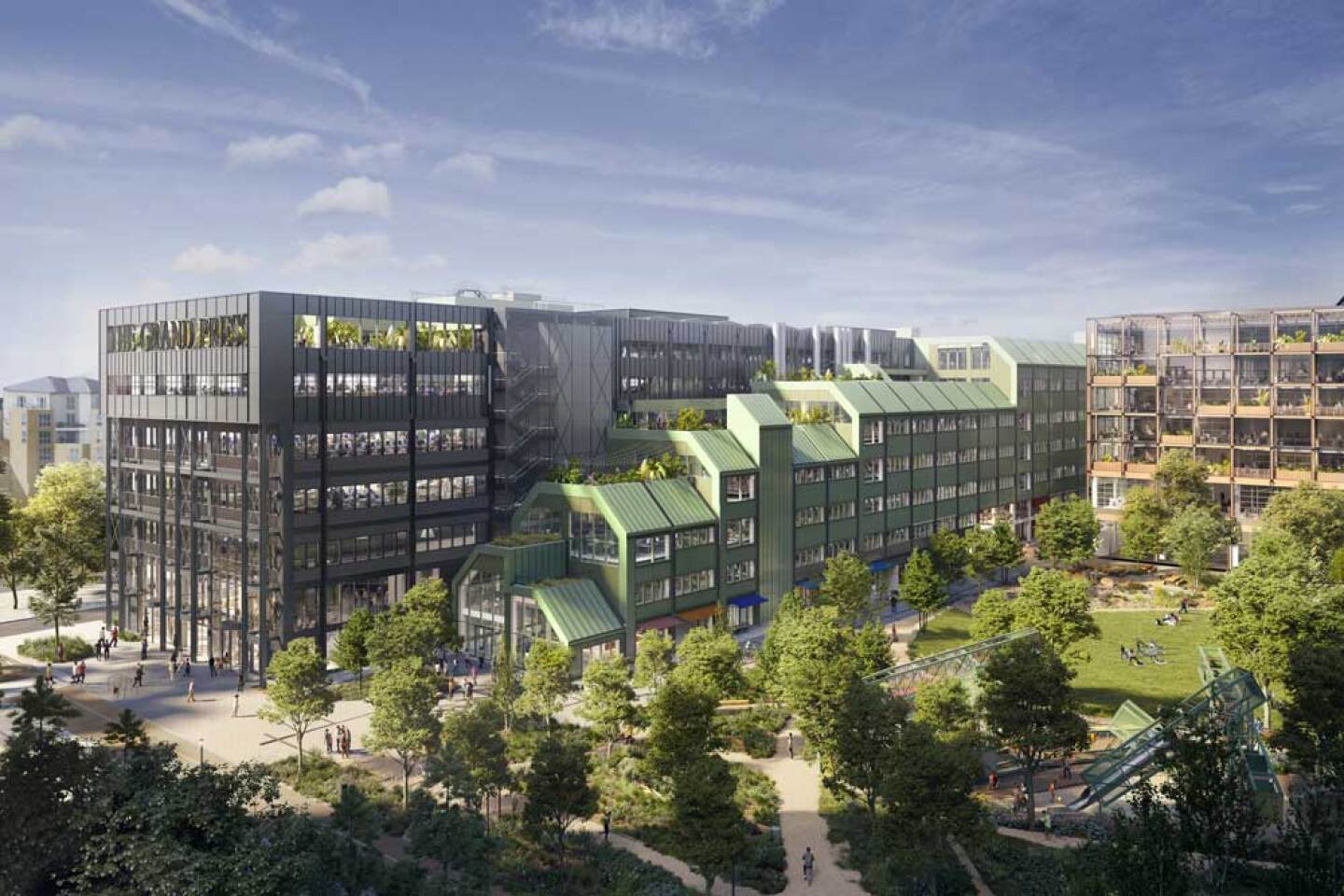For the last 400 years, the Rotherhithe Peninsula in London’s East End has been a gateway to new worlds. It’s where Captain William Bradford enjoyed his last drink in England before sailing off on the Mayflower in 1620. It’s where most imported Canadian lumber and agricultural products were once unloaded. And today, it’s the home of Canada Water, a new town center developers hope will open new frontiers for British urban planning.
Following a masterplan adopted by British Land, the AustralianSuper pension fund, and the Southwark Council, developers are now seven years into a 15-year project to transform a 53-acre (21.44 hectares) parcel of industrial land and a former quay into a community that will include as many as 3,000 new homes, 2 million square feet (185,806 square meters) of office space and 1 million square feet (92,903 square meters) of retail, leisure, and entertainment space.
This year, the developers are scheduled to deliver 300,000 square feet (27,870 sq m) of workspace, 13,000 square feet (1,207 sq m) of retail space, a 186-unit residential tower, and a new public leisure center. And there is much more to come, including 16 new streets, a 3.5-acre (1.4-ha) park, and a new town square. In all, 35 percent of the masterplan is open space, a higher ratio than anywhere else in central London, with enough office space for as many as 20,000 workers.
In addition, the German property development group Art-Invest Real Estate is building Dockside Canada Water, a 4.5-acre (1.8-ha), 1.5-million-square-foot (139,354 sq-m) scheme adjacent to the British Land masterplan parcel and Canada Dock, the remnant of the former harbor that is now the centerpiece of the planned community. Art-Invest’s contributions will include student housing, offices, and retail.
“A series of wows”
From the moment he first saw the site in 2015, Roger Madelin felt it could be something special. “I was completely blown away…” says the joint head of the Canada Water development for British Land, whose prior career as CEO of Argent property group included another major London project, the redevelopment of Kings Cross.
Canada Water may be London’s biggest development in the past 50 years, but Madelin saw more to the parcel than scale. “It had all the things that you just thought, if you could make a piece of city better, what would you want? More green space. You’d want some blue space—you’d want access to water. And you’d want a planning policy that didn’t say, `Oh, you can’t do retail’ or `You can’t do leisure’—a planning policy that was much more into mixed use in which each use could help the value and the success of the other one.”
After accepting British Land’s offer to co-lead the project, Madelin gave the architects a simple directive: “`Could we just create a series of ‘wows’?’” he recalls asking. “You arrive, you go, `Wow, we’re in a beautiful place,’…you walk into a building, whether it’s an office building or a retail building or a cultural building, and you go ‘wow.’”
Beginning with two sides of waterfront at Canada Dock, the last remnant of a much larger harbor filled in during the 1980s, London architects Allies and Morrison have tried to oblige.
The Canada Water masterplan features several elements that echo the area’s history as a port, including a 524-foot (170-m) red pedestrian bridge by designer Asif Khan. The bridge echoes two historical red bridges that once, when raised at the same time, cut the peninsula off from the rest of London. The planners also made some streets narrow, echoing the area’s past as a home to docks and harbor warehouses, as well as adding other touches inspired by other waterside public spaces in the UK as well as in Rotterdam and Amsterdam, according to Sarah La Touche, a director at Allies and Morrison who began working on the masterplan in 2013.
There are also more wows than meet the eye. With respect to sustainability, for instance, Madelin notes that none of the buildings are supposed to use fossil fuels, which will make Canada Dock the largest such low-carbon development in the UK.
Phil Ryan, director, city futures, global insight, for JLL, an advisor to British Land, also pointed to the range of sizes and types of housing as an indication that the Canada Water teams are proceeding in an unusually thoughtful way.
The master plan has also earned high marks from Ryan and other real estate experts. The plan was made in close consultation with the 30,000 residents who live on the Rotherhithe Peninsula around Canada Dock, and redesigned as local needs and market demands have evolved, according to Michael Meadows, head of planning and public affairs at British Land.
“Being part of the community on the peninsula is hugely important to us,” Meadows says, who notes that British Land has listened to local feedback on the master plan design and even consulted the community about street names.
While not part of the masterplan, Chris Schorah, senior development manager for Art-Invest in London, says the group is coordinating with British Land through such means as using the same landscape architecture firm, Townsend, to further integrate the parcels. “We really want there to be a cohesive approach to the public realm,” Schorah says.
Staying ahead of the curve
JLL’s Ryan gives British Land good marks on both the planning and the pace of development. The company has “a strong understanding of what makes good places.” At the same time, however, they have developed in line with where they think the market is heading. They are “good at reading the room and knowing when to be ahead of the curve,” Ryan says.
As Madelin and Ryan both noted, Canada Water’s flexible masterplan has been a key element of the development’s design and construction.
Drawn up by Allies and Morrison, which already had experience with the flexible use masterplan it created and followed during the Kings Cross redevelopment, the Canada Water dynamic masterplan was designed to follow flexible guidelines that could change over time, depending on market demand.
“If workspace is having challenges in the market, then at any one time, homes can be delivered, and vice versa, so there’s always something that can get done and can keep the project moving,” explains Allies and Morrison’s La Touche.
In the Canada Water plan’s first few years, the Southwark authorities were skeptical of the flexible approach. “It was difficult for Southwark to get their heads around…. there was still a bit of a leap of faith involved,” she recalls.
But now, this ability to keep pace with shifting demand has already proven to be a key advantage for the development, in Ryan’s view. “To keep the momentum going, you always want to have a steady pipeline—starting and stopping is way more expensive,” he explains.
Delegates at the 2025 ULI Europe Conference in London had the opportunity to participate in an extensive site tour of Canada Water which was organized with British Land and Art-Invest Real Estate. The 2026 ULI Europe Conference will take place 1-3 June 2026 in Berlin.








